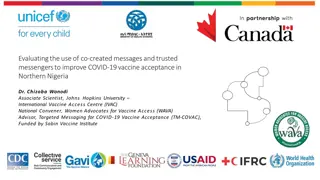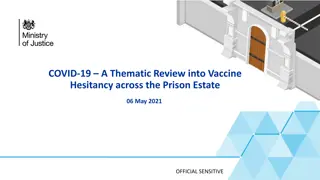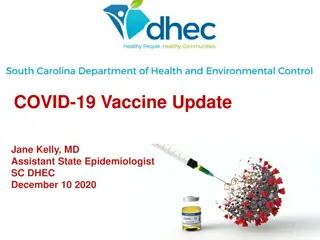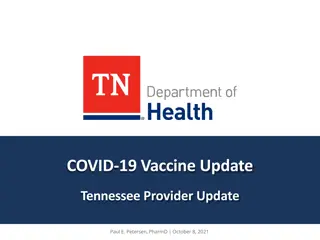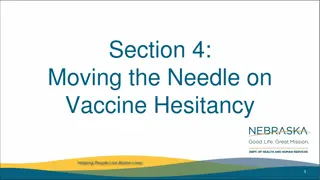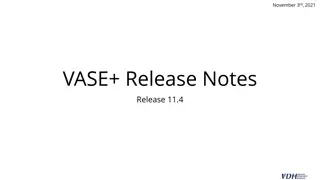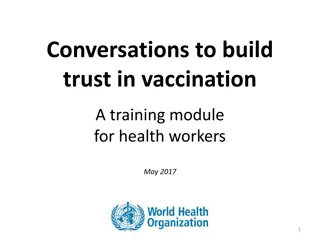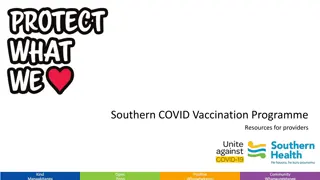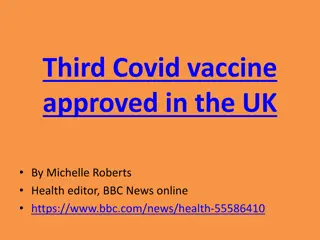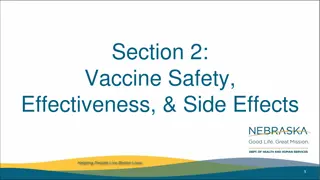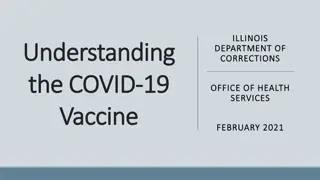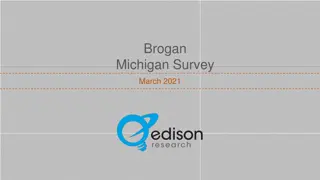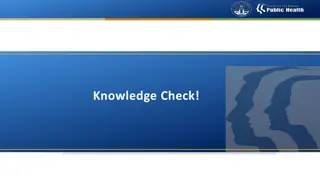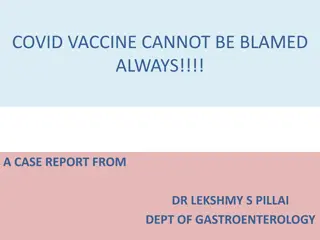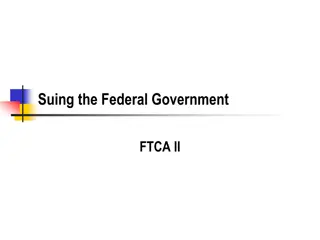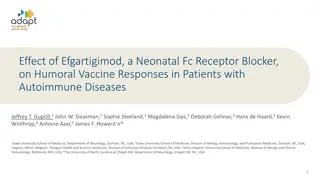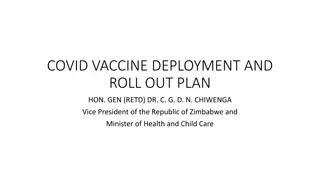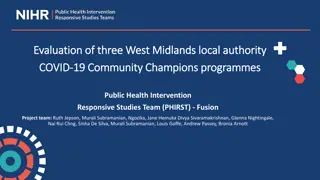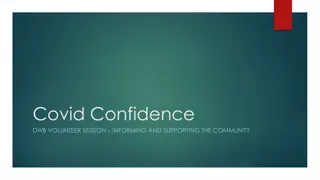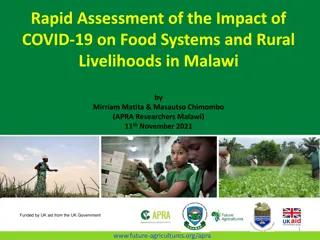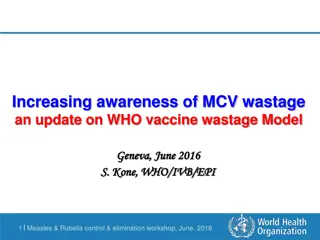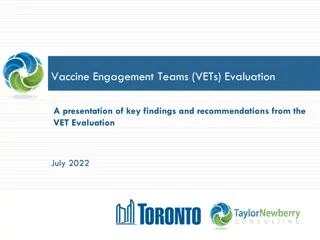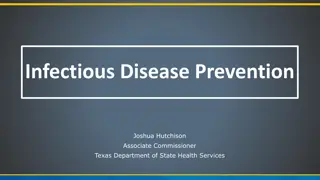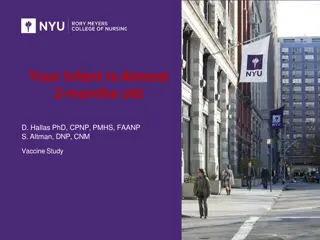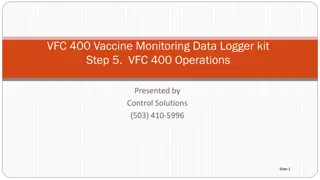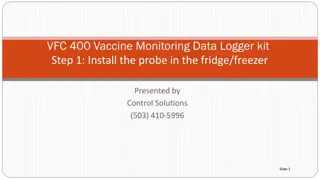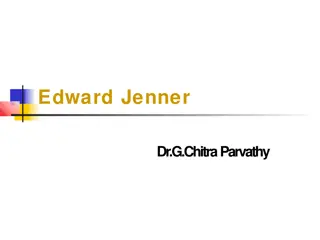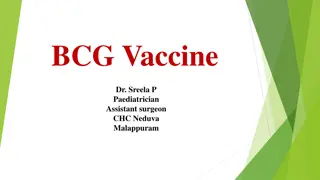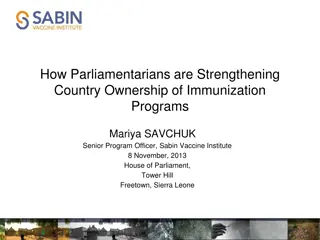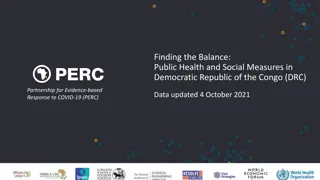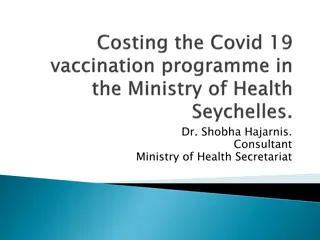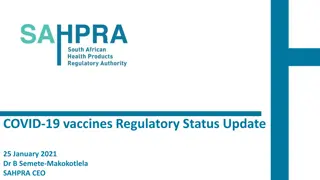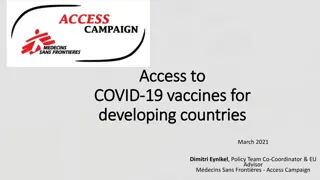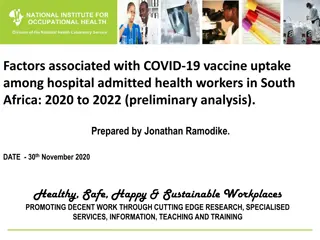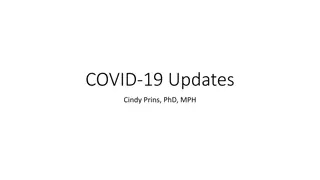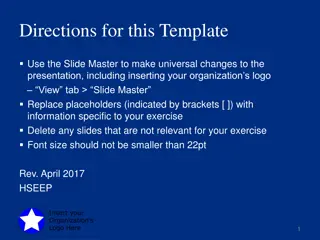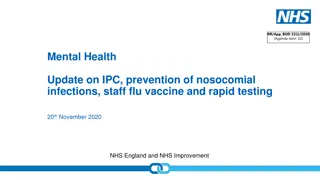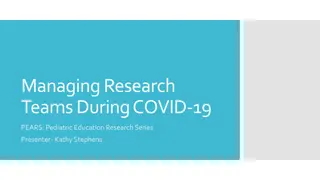Understanding COVID-19 Vaccine Hesitancy and Education in Healthcare
Discussing factors influencing COVID-19 vaccine acceptance, surveys on hesitancy, perspectives of older adults, and strategies for addressing concerns. Details on Pfizer and Moderna vaccines, efficacy data, side effects, and subgroup analyses are provided.
Download Presentation

Please find below an Image/Link to download the presentation.
The content on the website is provided AS IS for your information and personal use only. It may not be sold, licensed, or shared on other websites without obtaining consent from the author. Download presentation by click this link. If you encounter any issues during the download, it is possible that the publisher has removed the file from their server.
E N D
Presentation Transcript
COVID-19 Vaccine Hesitancy and Education: A Guide for Medical Directors
Kreps et al found in his survey published in JAMA 10/20/20 that the most important factors for acceptance are efficacy, duration of protection and lower incidence of major side effects Other factors: EUA (Emergency Use Authorization) and a vaccine developed outside the United States. Specific LTC staff concerns: being first Safety Not being represented in the vaccine trials COVID-19 vaccine hesitation is real JAMA Network Open. 2020;3(10):e2025594. doi:10.1001/jamanetworkopen.2020.25594
COVID-19 Hesitancy and Older Adults National Poll on Healthy Aging report,University of Michigan (November, 2020) MalaniP, Singer D, Solway E, Kirch M, KullgrenJ. Older Adults Perspectives on a COVID-19 Vaccine. University of Michigan National Poll on Healthy Aging. November 2020. Available at: http://hdl.handle.net/2027.42/163523
How to Frame the Conversation Most Important: This is what we have been waiting for! This is how we save lives, our own and everyone around us For the first time in the United States, long term care staff are first, we have risked our lives caring for our residents and now we can protect everyone by getting the vaccine Meet people where they are Everyone has questions and concerns Listen and respond compassionately Answer questions with respect and honesty
Pfizer (BNT162b2) Moderna(mRNA-1273) 25,654 alreadyreceived 2nddose (>30,000 enrolled) Trial Size 41,135 already received 2nddose (43,661 total enrolled) Efficacy 95% (162cases placebo group vs 8 cases in vaccine group) 94.5% (90 cases placebo group vs 5 cases vaccine group interim analysis) 7 days from 2nddose Immunity onset N/A Severe cases 9 in placebo group vs 1 in vaccine group 11in placebo vs 0 in vaccine group Primary Side effects Fatigue 3.8% Headache 2.0% No severe adverseevents Older adults fewer side effects Injectionsite pain 2.7% Fatigue 9.7% Myalgia 8.9% Arthralgia 5.2% Headache 4.5% Pain 4.1% Erythema/redness 2.0% No severe adverse events Older adults 45% age 56-85 (40.9% internationally) 94%efficacy for those >65 years in subgroup analysis >7,000 (23%) age >65 No difference in efficacy or side effects in subgroup analysis Minorities 30%racially/ethnically diverse backgrounds in US, 42% internationally -10.1% black (10.0% internationally) -13.1% Hispanic (26.1% internationally) No difference in efficacy or side effects in subgroup analysis >11,000from communities of color ->6,000 (>20%) self-identify as Hispanic/LatinX ->3,000 (>10%) self-identify as Black No difference in efficacy or side effects in subgroup analysis Sub-groups High Risk Conditions N/A 17% age 18-65with high risk condition (many people 65+ also had another high risk condition) -36% with DM among high risk group -25% with severe obesity among high risk group No difference in efficacy or side effects in subgroup analysis Storage Ultralow cold (-80 deg) 2-8 degC for 5 days 30 min 3 hour defrost time 6 hour post-dilution stability at room temperature Cold storage (-4 deg) 30 day shelf life in freezer 12 hour room temperature stability Storage Notes: Courtesy of Dr. Anuj Mehta, Data is accurate as of 11/18/2020. More information is constantly becoming available. Sub-group comparisons (e.g. comparisons about efficacy between races or age groups) may be less accurate due to smaller numbers. Sub-group numbers for the Pfizer vaccine are given for US participants with international percentages in parentheses. https://www.pfizer.com/news/press-release/press-release-detail/pfizer-and-biontech-conclude-phase-3-study-covid-19-vaccine https://www.pfizer.com/science/coronavirus/vaccine https://investors.modernatx.com/news-releases/news-release-details/modernas-covid-19-vaccine-candidate-meets-its-primary-efficacy https://www.modernatx.com/sites/default/files/content_documents/2020-COVE-Study-Enrollment-Completion-10.22.20.pdf
A Strategy for COVID-19 Education Is it safe? Why should we trust the vaccine? Is there new technology being used and is that dangerous to me? What is an EUA and what does that mean for me? When and how long will I be protected? Will I still need to wear a mask? Expectations: Important to warn people about possible side effects Special circumstances: What if I had COVID-19 or if I have antibodies REVIEW: WHERE ARE YOU GETTING YOUR INFORMATION ?
Safety is the most important priority in vaccine approval Most adverse side effects occurwithin 6 weeks of vaccine administration, and the FDA has required 8 weeks of safety monitoring FDA advises a minimum of 3,000 participants to assess safety. The current phase 3 trials have 30,000 to 50,000 participants. This really demonstrates how safety is a top priority for the FDA and the medical community. Are the COVID-19 vaccines safe?
Why should we trust the COVID-19 vaccine? The FDA is using the same standards that it has for decades There are no steps being skipped 2 advisory committees: 1) The Vaccine and Related Biological Products Advisory Committee (VRBPAC) that advises the FDA 2) The Advisory Committee on Immunization Practices (ACIP) that advises the CDC.
mRNA Vaccines Viral Vectors Can these new technologies give me COVID-19? NO Can these new technologies change my DNA? NO New technology for the COVID-19 vaccine
An Emergency Use Authorization (EUA) for a vaccine is based on the need to use a vaccine quickly to save lives during a public health emergency. EUA is a shorter process but no steps are skipped in the safety evaluation process. FDA approval can still take weeks The FDA will assess if the vaccine's known and potential benefits outweigh the known and potential risks. Both advisory boards (VRBPAC and ACIP) will also review all the data and make recommendations An EUA does not imply that the authorization was done too quickly or that the vaccine is not safe What is an EUA and what does that mean for me?
Be Transparent and Honest We will most likely not know how long the vaccine will be protective when we receive it More research needed Most of the vaccines are 2 doses, 3-4 weeks apart Protection 1-2 weeks after the second dose May need to have vaccine shots for COVID-19 on a regular basis (like the flu shot) but time will tell When and how long will I be protected by the COVID-19 vaccine?
Will I still need to wear a mask after I receive the vaccine? YES !
short-term discomfort : headache, muscle pains, fatigue, chills, fever and pain at injection site 1-2 days Same symptoms as COVID-19 Emphasize that the vaccine cannot give you COVID-19 May be more pronounced with second dose Normal and common It means your body is doing its job and making antibodies ( IT IS A GOOD THING) MUST COME BACK FOR SECOND DOSE FOR THE VACCINE TO BE EFFECTIVE Must be the same vaccine as the first dose Important: warn about possible side effects Will the vaccine make me sick?
Special It is safe to get the COVID-19 vaccine even if you have had COVID-19 If + Antibodies PLEASE get the COVID 19 Vaccine Monoclonal antibody treatment trial circumstances: Past COVID-19 infection or tested for antibodies
Where are you getting your information? It is important to get information from reliable sources (CDC, medical directors, providers) Social media is full of misinformation and opinions based on that misinformation CDC: https://www.cdc.gov/vaccines/hcp/covid- conversations/answering-questions.html CDC: About COVID-19 vaccines: https://www.cdc.gov/coronavirus/2019-ncov/vaccines/about- vaccines.html CDC: Provider Resources for COVID-19 Vaccine Conversations with Patients and Answering Patients Questions: https://www.cdc.gov/vaccines/hcp/covid-conversations/
You will be the leader and role model Tell your own vaccine story: talk about how will you make your decision Lead by doing: Discuss with staff/family your decision to get the vaccine and talk about your experience after you get immunized


